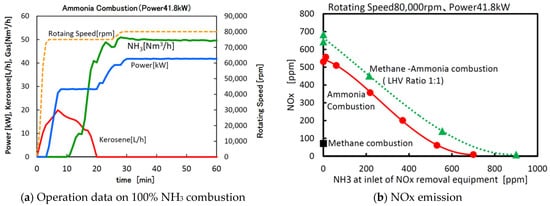Your browser does not fully support modern features. Please upgrade for a smoother experience.

Submitted Successfully!
Thank you for your contribution! You can also upload a video entry or images related to this topic.
For video creation, please contact our Academic Video Service.
| Version | Summary | Created by | Modification | Content Size | Created at | Operation |
|---|---|---|---|---|---|---|
| 1 | Hookyung Lee | + 2871 word(s) | 2871 | 2021-11-18 08:00:14 | | | |
| 2 | Jessie Wu | Meta information modification | 2871 | 2021-11-30 02:41:40 | | |
Video Upload Options
We provide professional Academic Video Service to translate complex research into visually appealing presentations. Would you like to try it?
Cite
If you have any further questions, please contact Encyclopedia Editorial Office.
Lee, H. R&D Activities on Gas Turbine System. Encyclopedia. Available online: https://encyclopedia.pub/entry/16517 (accessed on 11 January 2026).
Lee H. R&D Activities on Gas Turbine System. Encyclopedia. Available at: https://encyclopedia.pub/entry/16517. Accessed January 11, 2026.
Lee, Hookyung. "R&D Activities on Gas Turbine System" Encyclopedia, https://encyclopedia.pub/entry/16517 (accessed January 11, 2026).
Lee, H. (2021, November 29). R&D Activities on Gas Turbine System. In Encyclopedia. https://encyclopedia.pub/entry/16517
Lee, Hookyung. "R&D Activities on Gas Turbine System." Encyclopedia. Web. 29 November, 2021.
Copy Citation
Carbon-free ammonia combustion technology
R&D activities
Gas Turbine System
Ammonia
Combustion
Carbon-free
Power Generation
1. Introduction
Energy is a driving force for national industrial development and economic growth, and for the affluent life of people, and its consumption inevitably increases continuously. Humans have led economic and industrial development by using hydrocarbon-based fossil fuels such as coal and petroleum, and they are prevalent in developing countries. As the severity of the climate change problem increased about 150 countries agreed to co-operate and a climate change agreement was adopted at the Rio Environmental Conference in June 1992, and the Kyoto Protocol in 1996 to solve the global warming problem in earnest. This gradually expanded and led to the international treaty of the Paris Agreement in 2015, and governments were advised to submit long-term low greenhouse gas emission development strategies to the international community by 2020 in accordance with the Paris Agreement. At the same time, each country had declared that it will achieve carbon neutrality by 2050 or at the longest by 2060. Most of them set the target for 2050 because the Intergovernmental Panel on Climate Change (IPCC) suggested to limit the increase in global average temperature to 1.5 °C by 2100. This is because it suggested a path that global carbon dioxide emissions should be reduced by at least 45% compared to 2010 by 2030, and that carbon-neutrality should be achieved by 2050. Therefore, in line with the Paris Agreement’s guidelines, and the goal of limiting the increase in global average temperature to 1.5 °C or less, most countries aim to reduce greenhouse gas emissions from human activities to the fullest extent; to absorb and remove emitted carbon, and bring the actual emissions to zero. Achieving carbon neutrality is a very challenging goal; however, the international community is demanding a higher achievement. Further details on this are contained in the biennial update reports, and COP26 will be held in the UK to discuss the latest developments [1]. To realize greenhouse gas reduction through innovation in the face of tightening environmental regulations, the development and early commercialization of prospective energy technology and investment to support them are emphasized.
The Netherlands Environmental Assessment Organization estimates that the world emitted 57.4 Gt CO2eq greenhouse gases in 2019 [2]. Among them, global energy-related carbon dioxide (CO2) emissions are 33.4 Gt CO2eq. This amount is also consistent with that reported by the IEA [3]. The continuous increase of CO2 in the atmosphere is mainly driven by fossil fuel combustion and calcination of carbonates. The dominant drivers of CO2 are the combustion of coal, oil, and natural gas, representing 89% of global CO2 emissions, with respective shares of 39%, 31%, and 18%. In particular, the combustion of fuel in thermal power plants is a major cause of large-scale CO2 generation and accounts for the dominant proportion of the electricity generation sector. In the field, coal, a solid fuel, is mainly used in coal-fired power plants, and gaseous fuels such as natural gas are mainly used in combined cycle power plants, including gas turbines.
The dominance of greenhouse gas emissions from fossil fuel combustion has already been well demonstrated in existing analysis data, and associated researchers in the fields of combustion, energy, and the environment are well aware of this fact. Therefore, it is unnecessary to say that innovative development of fuel combustion technology is needed to meet the future carbon-neutral system goals. However, the innovation in energy conversion is being promoted more rapidly than in the past, and intensive R&D activities are needed to support this technology. Although global R&D activities to move towards a renewable and hydrogen society are mainly centered on transportation and fuel cells, there are still many goals to be achieved for the full-cycle, large-scale practical use of hydrogen production, transport, supply, and utilization for commercialization. As it has been consistently mentioned in the past, it will take a long time as well a huge socio-economic investment for the government and private sector to establish an infrastructure for the supply of hydrogen.
Therefore, to implement the rapidly changing carbon emission reduction regulations and fulfill the promises made with the international community, technologies that are relatively easy to commercialize need to be implemented. Methods for reducing greenhouse gases include improving the thermal system efficiency and capturing CO2 through downstream facilities. However, it would be economical in terms of post-treatment cost if the combustion stage uses a fuel that does not emit carbon from the source. The cost of producing a carbon-free fuel and the CO2 footprint must be considered together. Ammonia (NH3) is expected to be a carbon-free fuel. To realize a carbon-neutral society in 2050, for example, Japan has presented an action plan for 14 important areas that are expected to grow in the future as a greenhouse gas reduction industry in terms of growth strategies. In particular, they emphasized that ammonia is an effective fuel when combusted with pulverized coal in a coal-fired boiler. In addition, R&D was conducted to apply fuel ammonia to coal-fired power plants, gas turbine combustion, and industrial furnace combustion through the cross-ministerial strategic innovation promotion program (SIP) project from 2014 to 2018 [4]. Through this project, the technical feasibility of using fuel ammonia has been verified, and research is underway with the goal of commercializing the related technology through the new energy and industrial technology development organization (NEDO) project, a follow-up task [5]. Because the advantages (carbon-free fuel) and disadvantages (low reactivity and fuel-NOx production) of using ammonia as a fuel clearly exist, research has been conducted to overcome these technical bottlenecks and supply problems, and some of the results linked to demonstrations show the effect of reducing greenhouse gas emissions [6][7][8][9].
Ammonia was first studied as an alternative fuel for internal combustion engines rather than for reducing greenhouse gas emissions. As available resources became scarce due to World War II, interest was drawn in fuels other than fossil fuels, and accordingly, the possibility of using ammonia as a fuel drew attention [10][11][12][13][14][15][16]. The technology of using ammonia as a fuel in automobile internal combustion engines has been used for trucks in Norway since the 1930s, and was developed in Belgium in 1943 [17]. In the 2000s, there was a research case of a compression ignition engine to which a mixed combustion system of ammonia-diesel and ammonia-DME fuel was applied [18][19]. The optimal ammonia co-firing rate was 60%, and when it was lower than this, the flame temperature decreased and the amount of NOx produced decreased compared to when only diesel fuel was used. However, as the ammonia ratio increased, the amount of NOx produced due to nitrogen contained in the fuel increased sharply. Currently, research is underway to apply ammonia to spark-ignition engines [20][21]. In addition, there are quite a lot of research results aimed at overcoming the challenge of its low reactivity, and most of the results have proposed to achieve this by blending ammonia with a high-reactivity fuel [22][23]. Regarding the production of prototype vehicles using ammonia as fuel, in 2007, the University of Michigan developed an ammonia-gasoline combustion engine and operated it from Detroit to San Francisco [24]. In 2013, the Korea Institute of Energy Research developed an ammonia-gasoline engine, called AmVeh, by remodeling a gasoline-LPG fueled engine [25]. Recently, the development of fuel-powered ships utilizing LNG, hydrogen, and ammonia for low-carbon emissions has been notable [26][27]. Ammonia-fueled propulsion ship development plans are being reported mainly by companies [28][29][30][31][32]. In addition, research on the concept of a marine engine for hydrogen-ammonia co-firing is in progress [33][34][35]. Kim et al. conducted environmental and economic assessments associated with an alternative ship propulsion system fueled by ammonia [36]. Technologies capable of emitting greenhouse gases from the operational aspects of ships were reviewed by Bouman et al. [37].
In the field of thermal power generation that we discuss in this study, the combustion characteristics of ammonia and their application to gas turbines and coal-fired boilers are being studied mainly in Japan, the United Kingdom, and Korea. Looking at what these countries have in common, they are surrounded by sea rather than connected to other countries (South Korea is a militarily divided country) and continents, and are characterized by high energy-use intensity. To achieve hydrogen economy and a carbon-neutral society, it is necessary to increase the production and use of hydrogen fuel. It is well known that hydrogen is produced by processes such as reforming and water electrolysis, unlike fuels mined in nature [38][39][40][41][42]. However, there is a limit to the amount of hydrogen that can be produced in these countries. It is necessary to supplement it by shipping from other countries with abundant renewable energy for the introduction of green-hydrogen that does not emit CO2 during the water electrolysis process using solar power or blue-hydrogen by the reforming process with carbon capture and storage (CCS) facilities. Therefore, it is necessary to develop a material that can act as a carrier for hydrogen, and ammonia has been considered the most appropriate material [43][44][45]. There are also a number of studies comparing the transport mediums of hydrogen [46][47][48][49][50][51][52][53]. Hydrogen can be produced by cracking ammonia; however, ammonia itself is a combustible material with a calorific value and can be used as a fuel in a thermal system. Therefore, ammonia could be used directly as a fuel, and combustion characteristics were studied because the ammonia-cracking process required another energy source. This also has the advantage that the unit cost of ammonia is much lower than that of hydrogen [43][44][45].
Figure 1 shows the CO2-free ammonia value chain used in a direct combustion system through the transport process after the green-hydrogen, produced through the water electrolysis process using renewable energy, and the blue-hydrogen, through the fossil fuel reforming process with CCS, are synthesized into ammonia. The current large-scale ammonia production is achieved by the Haber-Bosch process. In the future, the power used to maintain the operating conditions in the Haber-Bosch process must also be produced from renewable energy sources to achieve a truly carbon-neutral system [54].
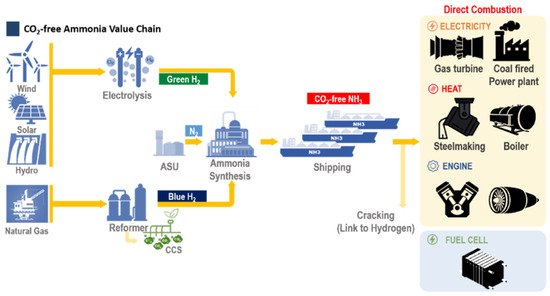
Figure 1. A schematic flow on CO2-free ammonia value chain.
In the present study, the recent R&D trends associated with gas turbines and coal-fired boilers using fuel ammonia are summarized by presenting the application results for demonstration. The experimental research results of the institutions that have been investigating fundamental combustion characteristics for a long time are summarized for the development of such commercial facilities. Finally, the brief research results of the Korea Institute of Energy Research, which is leading the ammonia combustion technology in Korea, are reported.
2. R&D Activities on Gas Turbine System
2.1. Lab-Scale Model Burner for Ammonia-Rich Mixture Combustion
A research team from Cardiff University in the UK worked on an ammonia gas turbine [55][56][57][58]. The superiority of ammonia as a storage material for hydrogen and the possibility for direct combustion was evaluated. Finally, they announced that an ammonia-hydrogen dual-fuel approach will be applied in their facility, with the hydrogen generated in a pre-combustion ammonia cracking step. Valera-Media et al. conducted an experiment for stable combustion operation when hydrogen was added using a 70% NH3-30% H2 (mol%) blend [55].
Figure 2 shows an optical generic swirl-burner and OH* intensity results. Under fuel-rich conditions, the measurement results showed that the OH* intensities were still high, along with an increase in the consumption of OH* at the flame front at high inlet temperatures. They also investigated ammonia-methane combustion in swirl burners, as shown in Figure 3 [56]. A fully premixed injection was not appropriate for optimized ammonia combustion, and flame instabilities were produced at a medium swirl burner; hence, a lower swirl and another injection method were required.
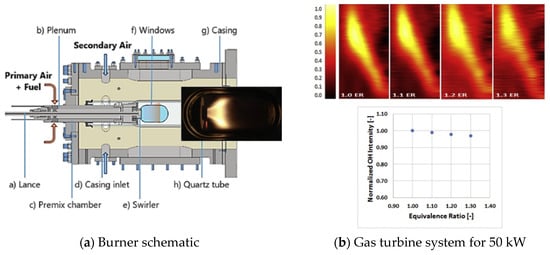
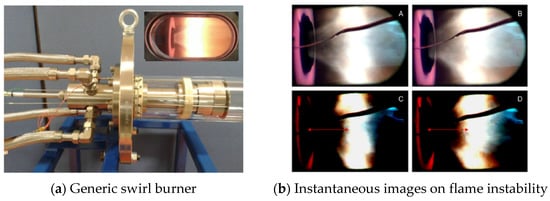
Figure 3. Gas turbine model combustor and direct images on NH3-CH4 flames of 61% NH3 and 39% CH4: (a) Gas turbine model combustor with NH3-CH4 blend flame at equivalence ratio 1.31 for 31.7 kW; (b) Instantaneous photographs on flame position change (instability). Modified from [56]. Courtesy of Elsevier [56].
2.2. 50 kW Small-Scale System
A research team in Japan succeeded in generating a 41.8 kW class gas turbine using ammonia as fuel. This development was carried out in close cooperation with the group at Tohoku University and the National Institute of Advanced Industrial Science and Technology (AIST). The combustion and power generation system optimized for bi-fuel supply was developed by remodeling the combustor of Toyota Turbine and System Inc.’s micro gas turbine. In the early stage of development, approximately 30% of ammonia was mixed with methane to generate 21 kW of power. Subsequently, R&D was carried out with the goal of operating a gas turbine using ammonia as the main fuel. In 2016, the ammonia supply facility and the methane supply facility were repaired, and a demonstration test for gas turbine power generation using ammonia as the main fuel was conducted. The main performance goals were to maintain compatibility with the existing power generation system and to minimize NOx emissions.
Figure 4 shows the ammonia combustor (prototype bi-fuel combustor) and the overview of the gas turbine system. Although NOx concentration in the exhaust gas of ammonia combustion exceeded 600 ppm, as shown in Figure 5, NOx removal equipment (SCR) can reduce NOx concentration below 10 ppm [59]. They have reported the results of related studies every year, and recently [60][61][62][63][64], they have also conducted research on burning liquid ammonia by directly spraying it into a combustor [65].
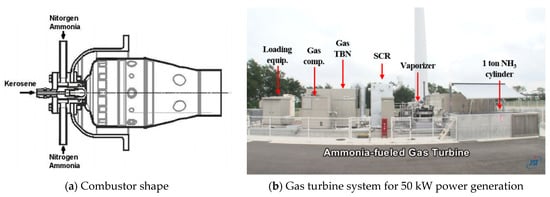
Figure 4. 50 kW class NH3 burning gas turbine combustor and power generation system: (a) NH3 combustor for prototype bi-fuel combustion; (b) Test facilities for micro gas turbine power generation with large amount of NH3 gas supply (1 ton cylinder). Modified from [59]. Courtesy of Ammonia Energy Association [59].
2.3. 2 MW Medium-Scale System
IHI Corporation is a representative company participating in the organization for the commercialization of ammonia combustion technology for gas turbines, coal-fired power plants, and fuel cells in the SIP program. IHI evaluated the NOx emission characteristics and efficiency of the power generation system by co-firing ammonia up to 20% based on the calorific value in the existing 2 MWe class LNG gas turbine [66][67]. Figure 6 shows the overview of the gas turbine of the power generation system. When ammonia was not added during rated load operation, about 100 ppm of NOx was emitted; however, as the co-firing rate of ammonia increased, the NOx emission increased up to three times. Similar to the results of AIST, in this study, NOx emissions of up to 6 ppm were achieved using the downstream SCR facility, and performance to satisfy environmental regulations was secured using a commercial SCR facility. A dramatic increase in NOx emissions during ammonia co-firing is an issue that must be overcome, and to apply ammonia to a medium-to-large gas turbine system in the future, it is necessary to minimize NOx emissions from the combustor itself.

When the ammonia co-firing rate was 5%, the efficiency tended to decrease slightly; however, when the ammonia co-firing rate was 10% or more, the overall efficiency increased. As the mixing ratio was controlled based on the calorific value, the input amount of ammonia having a relatively low calorific was increased, and thus the turbine inlet flow rate increased, as shown in Figure 7.

Recently, IHI announced that it has raised the liquid ammonia co-firing ratio on a 2 MW-class gas turbine to 70% on a heating value basis [68]. This technology enables the spraying of liquid ammonia directly into the combustor for mixing with natural gas while constraining NOx emissions. IHI has attained 100% liquid ammonia-fueled combustion with this technology on a limited basis. It aims to ensure operational stability and suppress NOx and other emissions for commercializing a fully ammonia-fired gas turbine by 2025.
2.4. Developmet Plan of Commercial Large-Scale System
Hundreds of MW-class large gas turbines are being developed mainly for fuel supply systems. Unlike small- and medium-sized systems, large gas turbines are expected to have more severe restrictions on the size of the combustor for complete combustion of ammonia and more difficult control of NOx under high-temperature combustion conditions. Mitsubishi Power announced the start of the development of a 40 MW-class ammonia gas turbine in March 2021, and aims to commercialize it in 2025 after undergoing combustion and related operation tests [69]. Again, a technical bottleneck is the generation of NOx due to the nitrogen component of the fuel, and Mitsubishi is trying to solve the problem with a new ammonia combustor and SCR in the H-25 series gas turbine. Figure 8 shows the H-25 series gas turbine model of Mitsubishi.
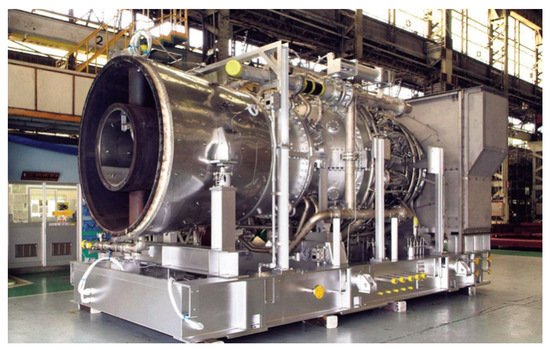
Figure 8. Mitsubishi H-25 series gas turbine [69].
General Electric (GE) and IHI have signed a memorandum of understanding for the development of a retrofit of an existing gas turbine for the combustion of ammonia fuel and a new gas turbine [70]. As the ammonia gas turbine market is widely distributed in Asia, including Korea and Japan, GE seems to have an idea to use ammonia in their own gas turbine technology. IHI is also planning to strengthen IHI’s competitiveness through GE, which has flexible fuel combustion technology in the gas turbines.
References
- Biennial Update Report submissions from Non-Annex I Parties. Available online: https://unfccc.int/BURs (accessed on 30 July 2021).
- Olivier, J.; Peters, J. Trends in Global CO2 and Total Greenhouse Gas Emissions: 2020 Report; PBL Netherlands Environmental Assessment Agency: The Hague, The Netherlands, 2020.
- Global Energy Review 2021 CO2 Emissions. Available online: https://www.iea.org/reports/global-energy-review-2021/co2-emissions (accessed on 9 July 2021).
- SIP-Energy Carriers. Available online: https://www.jst.go.jp/sip/k04.html (accessed on 5 August 2021).
- Feasibility Study under NEDO Program on Ammonia Co-Firing in Thermal Power Generation Facility. Available online: https://www.jera.co.jp/english/information/20200327_479 (accessed on 5 August 2021).
- Sanchez, A.; Castellano, E.; Martin, M.; Vega, P. Evaluating ammonia as green fuel for power generation: A thermos-chemical perspective. Appl. Energy 2021, 293, 116956.
- Yapicioglu, A.; Dincer, I. A review on clean ammonia as a potential fuel for power generators. Renew. Sustain. Energy Rev. 2019, 103, 96–108.
- Dreizler, A.; Pitsch, H.; Scherer, V.; Schulz, C.; Janicka, J. The role of combustion science and technology in low and zero impact energy transformation processes. Appl. Energy Combust. Sci. 2021, 7, 100040.
- Zamfirescu, C.; Dincer, I. Using ammonia as a sustainable fuel. J. Power Sources 2008, 185, 459–465.
- Verkamp, F.; Hardin, M.; Williams, J. Ammonia combustion properties and performance in gas-turbine burners. Proc. Combust. Inst. 1967, 11, 985–992.
- Chiong, M.; Chong, C.; Ng, J.; Mashruk, S.; Chong, W.; Samiran, N.; Mong, G.; Valera-Medina, A. Advancements of combustion technologies in the ammonia-fuelled engines. Energy Convers. Manag. 2021, 244, 114460.
- Dimitriou, P.; Javaid, R. A review of ammonia as a compression ignition engine fuel. Int. J. Hydrogen Energy 2020, 45, 7098–7118.
- Martins, J.; Brito, F. Alternative fuels for internal combustion engines. Energies 2020, 13, 4086.
- Cardoso, J.; Silva, V.; Rocha, R.; Hall, M.; Costa, M.; Eusebio, D. Ammonia as an energy vector: Current and future prospects for low-carbon fuel applications in internal combustion engines. J. Clean. Prod. 2021, 296, 126562.
- Zamfirescu, C.; Dincer, I. Ammonia as a green fuel and hydrogen source for vehicular applications. Fuel Process. Technol. 2009, 90, 729–737.
- Miura, D.; Tezuka, T. A comparative study of ammonia energy systems as a future energy carrier, with particular reference to vehicle use in Japan. Energy 2014, 68, 428–436.
- Kroch, E. Ammonia–A fuel for motor buses. J. Inst. Pet. 1945, 213–223.
- Kong, S.; Reiter, A. Combustion and emissions characteristics of compression-ignition engine using dual ammonia-diesel fuel. Fuel 2011, 90, 87–97.
- Kong, S.; Gross, C. Performance characteristics of a compression-ignition engine using direct-injection ammonia-DME mixtures. Fuel 2013, 103, 1069–1079.
- Lhuillier, C.; Brequigny, P.; Contino, F.; Mounaim-Rousselle, C. Experimental investigation on ammonia combustion behavior in a spark-ignition engine by means of laminar and turbulent expanding flames. Proc. Combust. Inst. 2021, 38, 5859–5868.
- Oh, S.; Park, C.; Kim, S.; Kim, Y.; Choi, Y.; Kim, C. Natural gas-ammonia dual-fuel combustion in spark-ignited engine with various air-fuel ratios and split ratios of ammonia under part load condition. Fuel 2021, 290, 120095.
- Issayev, G.; Giri, B.; Elbaz, A.; Shrestha, K.; Mauss, F.; Roberts, W.; Farooq, A. Combustion behavior of ammonia blended with diethyl ether. Proc. Combust. Inst. 2021, 38, 499–506.
- Boretti, A. Novel dual fuel diesel-ammonia combustion system in advanced TDI engines. Int. J. Hydrogen Energy 2017, 42, 7071–7076.
- Grannell, S. The Operating Features of a Stoichiometric, Ammonia and Gasoline Dual Fueled Spark Ignition engine. Ph.D. Thesis, University of Michigan, Ann Arbor, MI, USA, 2008.
- Jang, J.; Woo, Y.; Yoon, H.; Kim, J.; Lee, Y.; Kim, J. Combustion characteristics of ammonia-gasoline dual-fuel system in one liter engine. J. Korean Inst. Gas 2015, 19, 1–7.
- Al-Aboosi, F.; El-Halwagi, M.; Moore, M.; Nielsen, R. Renewable ammonia as an alternative fuel for the shipping industry. Curr. Opin. Chem. Eng. 2021, 31, 100670.
- Mckinlay, C.; Turnock, S.; Hudson, D. Route to zero emission shipping: Hydrogen, ammonia or methanol? Int. J. Hydrogen Energy 2021, 46, 28282–28297.
- MAN Energy Solutions is Developing a Fuel-Flexible, Two-Stroke Ammonia Engine as a Key Technology in the Maritime Energy Transition. Available online: https://www.man-es.com/discover/two-stroke-ammonia-engine (accessed on 12 August 2021).
- World’s First Full Scale Ammonia Engine Test—An Important Step towards Carbon Free Shipping. Available online: https://www.wartsila.com/media/news/30-06-2020-world-s-first-full-scale-ammonia-engine-test---an-important-step-towards-carbon-free-shipping-2737809 (accessed on 12 August 2021).
- Daewoo Wins Approval for Ammonia-Fired Ship from Lloyd’s Register. Available online: http://www.koreaherald.com/view.php?ud=20201006000301 (accessed on 12 August 2021).
- Samsung Heavy Gets Nod for Ammonia-Fueled Ships from Lloyd’s Register. Available online: https://en.yna.co.kr/view/AEN20200924003200320 (accessed on 12 August 2021).
- Hyundai Mipo Gets Approval for Ammonia-Fueled Ships from Lloyd’s Register. Available online: https://en.yna.co.kr/view/AEN20200723004600320 (accessed on 12 August 2021).
- Boretti, A. Novel heavy duty engine concept for operation duel fuel H2-NH3. Int. J. Hydrogen Energy 2012, 37, 7869–7876.
- Wang, Y.; Zhou, X.; Liu, L. Theoretical investigation of the combustion performance of ammonia/hydrogen mixtures on a marine diesel engine. Int. J. Hydrogen Energy 2021, 46, 14805–14812.
- Morch, C.; Bjerre, A.; Gottrup, M.; Sorenson, S.; Schramm, J. Ammonia/hydrogen mixtures in an SI-engine: Engine performance and analysis of a proposed fuel system. Fuel 2011, 90, 854–864.
- Kim, K.; Roh, G.; Kim, W.; Chun, K. A preliminary study on an alternative ship propulsion system fueled by ammonia: Environmental and economic assessments. J. Mar. Sci. Eng. 2020, 8, 183.
- Bouman, E.; Lindstad, E.; Rialland, A.; Stromman, A. State-of-the-art technologies, measures, and potential for reducing GHG emissions from shipping—A review. Transp. Res. Part D 2017, 52, 408–421.
- Nikolaidis, P.; Poullikkas, A. A comparative overview of hydrogen production processes. Renew. Sustain. Energy Rev. 2017, 67, 597–611.
- Ashik, U.; Daud, W.; Abbas, H. Production of greenhouse gas free hydrogen by thermocatalytic decomposition of methane—A review. Renew. Sustain. Energy Rev. 2015, 44, 221–256.
- Chehade, G.; Dincer, I. Progress in green ammonia production as potential carbon-free fuel. Fuel 2021, 299, 120845.
- Pawar, N.; Heinrichs, H.; Winkler, C.; Heuser, P.; Ryberg, S.; Robinius, M.; Stolten, D. Potential of green ammonia production in India. Int. J. Hydrogen Energy 2021, 46, 27247–27267.
- Zhang, H.; Wang, L.; Van herle, J.; Marechal, F.; Desideri, U. Techno-economic comparison of green ammonia production processes. Appl. Energy 2020, 259, 114135.
- IEA, The Future of Hydrogen: Seizing Today’s Opportunities (Report Prepared by the IEA for the G20, Japan). Available online: https://www.iea.org/corrections/ (accessed on 1 July 2019).
- Brown, T. Ammonia: Zero-Carbon Fertiliser, Fuel and Energy Store; The Royal Society: London, UK, 2020; Available online: https://www.ammoniaenergy.org/articles/royal-society-publishes-green-ammonia-policy-briefing/ (accessed on 20 February 2020).
- Garcia, M. Hydrogen Economy Outlook: Key Messages. BloombergNEF. Available online: https://data.bloomberglp.com/professional/sites/24/BNEF-Hydrogen-Economy-Outlook-Key-Messages-30-Mar-2020.pdf (accessed on 30 March 2020).
- Wijayanta, A.; Oda, T.; Purnomo, C.; Kashiwagi, T.; Aziz, M. Liquid hydrogen, methylcyclohexane, and ammonia as potential hydrogen storage: Comparison review. Int. J. Hydrogen Energy 2019, 44, 15026–15044.
- Cesaro, Z.; Ives, M.; Nayak-Luke, R.; Mason, M.; Banares-Alcantara, R. Ammonia to power: Forecasting the levelized cost of electricity from green ammonia in large-scale power plants. Appl. Energy 2021, 282, 116009.
- Rouwenhorst, K.; Van der Ham, A.; Mul, G.; Kersten, S. Islanded ammonia power systems: Technology review & conceptual process design. Renew. Sustain. Energy Rev. 2019, 114, 109339.
- Aziz, M.; Wijayanta, A.; Nandiyanto, A. Ammonia as effective hydrogen storage: A review on production, storage and utilization. Energies 2020, 13, 3062.
- Makepeace, J.; He, T.; Weidenthaler, C.; Jensen, T.; Chang, F.; Vegge, T.; Ngene, P.; Kojima, Y.; Jongh, P.; Chen, P.; et al. Reversible ammonia-based and liquid organic hydrogen carriers for high-density hydrogen storage: Recent progress. Int. J. Hydrogen Energy 2019, 44, 7746–7767.
- Ishimoto, Y.; Voldsund, M.; Neksa, P.; Roussanaly, S.; Berstad, D.; Gardarsdottir, S. Large-scale production and transport of hydrogen from Norway to Europe and Japan: Value chain analysis and comparison of liquid hydrogen and ammonia as energy carriers. Int. J. Hydrogen Energy 2020, 45, 32865–32883.
- Hasan, M.; Mahlia, T.; Mofijur, M.; Fattah, I.; Handayani, F.; Ong, H.; Silitonga, A. A comprehensive review on the recent development of ammonia as a renewable energy carrier. Energies 2021, 14, 3732.
- Wan, Z.; Tao, Y.; Shao, J.; Zhang, Y.; You, H. Ammonia as an effective hydrogen carrier and a clean fuel for solid oxide fuel cells. Energy Convers. Manag. 2021, 228, 113729.
- Smith, C.; Hill, A.; Torrente-Murciano, L. Current and future role of Haber-Bosch ammonia in a carbon-free energy landscape. Energy Environ. Sci. 2020, 13, 331–344.
- Valera-Medina, A.; Gutesa, M.; Xiao, H.; Pugh, D.; Giles, A.; Goktepe, B.; Marsh, R.; Bowen, P. Premixed ammonia/hydrogen swirl combustion under rich fuel conditions for gas turbines operation. Int. J. Hydrogen Energy 2019, 44, 8615–8626.
- Valera-Medina, A.; Marsh, R.; Runyon, J.; Pugh, D.; Beasley, P.; Hughes, T.; Bowen, P. Ammonia-methane combustion in tangential swirl burners for gas turbine power generation. Appl. Energy 2017, 185, 1362–1371.
- Mashruk, S.; Xiao, H.; Valera-Medina, A. Rich-quench-lean model comparison for the clean use of humidified ammonia/hydrogen combustion systems. Int. J. Hydrogen Energy 2021, 46, 4472–4484.
- Bozo, M.; Vigueras-Zuniga, M.; Buffi, M.; Seljak, T.; Valera-Medina, A. Fuel rich ammonia-hydrogen injection for humidified gas turbines. Appl. Energy 2019, 251, 113334.
- Iki, N.; Kurata, O.; Matsunuma, T.; Inoue, T.; Suzuki, M.; Tsujimura, T.; Furutani, H.; Kobayashi, H.; Hayakawa, A.; Arakawa, Y.; et al. Micro gas turbine firing ammonia. In Proceedings of the 12th Annual NH3 Fuel Conference, Chicago, IL, USA, 20–23 September 2015.
- Iki, N.; Kurata, O.; Matsunuma, T.; Inoue, T.; Tsujimura, T.; Furutani, H.; Kobayashi, H.; Hayakawa, A.; Arakawa, Y.; Ichikawa, A. Micro gas turbine firing ammonia. In Proceedings of the ASME Turbo Expo 2016: Turbomachinery Technical Conference and Exposition, Seoul, Korea, 13–17 June 2016.
- Iki, N.; Kurata, O.; Matsunuma, T.; Inoue, T.; Tsujimura, T.; Furutani, H.; Kobayashi, H.; Hayakawa, A. Operation and flame observation of micro gas turbine firing ammonia. In Proceedings of the ASME Turbo Expo 2017: Turbomachinery Technical Conference and Exposition, Charlotte, NC, USA, 26–30 June 2017.
- Iki, N.; Kurata, O.; Matsunuma, T.; Inoue, T.; Tsujimura, T.; Furutani, H.; Kobayashi, H.; Hayakawa, A.; Okafor, E. NOx reduction in a swirl combustor firing ammonia for a micro gas turbine. In Proceedings of the ASME Turbo Expo 2018: Turbomachinery Technical Conference and Exposition, Oslo, Norway, 11–15 June 2018.
- Okafor, E.; Somarathne, K.; Hayakawa, A.; Kudo, T.; Kurata, O.; Iki, N.; Kobayashi, H. Toward the development of an efficient low-NOx ammonia combustor for a micro gas turbine. Proc. Combust. Inst. 2019, 37, 4597–4606.
- Okafor, E.; Somarathne, K.; Ratthanan, R.; Hayakawa, A.; Kudo, T.; Kurata, O.; Iki, N.; Tsujimura, T.; Furutani, H.; Kobayashi, H. Control of NOx and other emissions in micro gas turbine combustors fuelled with mixtures of methane and ammonia. Combust. Flame 2020, 211, 406–416.
- Okafor, E.; Kurata, O.; Yamashita, H.; Inoue, T.; Tsujimura, T.; Iki, N.; Hayakawa, A.; Ito, S.; Uchida, M.; Kobayashi, H. Liquid ammonia spray combustion in two-stage micro gas turbine combustors at 0.25 MPa; Relevance of combustion enhancement to flame stability and NOx control. Appl. Energy Combust. Sci. 2021, 7, 100038.
- Ito, S.; Uchida, M.; Suda, T.; Fujimori, T. Development of ammonia gas turbine co-generation technology. IHI Eng. Rev. 2020, 53, 1–6.
- Uchida, M.; Ito, S.; Suda, T.; Fujimori, T. Performance of ammonia/natural gas co-fired gas turbine with two-stage combustor. In Proceedings of the AIChE annual meeting, Orlando, FL, USA, 10–15 November 2019.
- IHI Becomes World’s First to Attain 70% Liquid Ammonia Co-Firing Ratio on 2000-Kilowatt-Class Gas Turbine. Available online: https://www.ihi.co.jp/en/all_news/2020/resources_energy_environment/1197060_2032.html (accessed on 9 July 2021).
- Mitsubishi Power Commences Development of World’s First Ammonia-Fired 40 MW Class Gas Turbine System–Targets to Expand Lineup of Carbon-Free Power Generation Options, with Commercialization around 2025. Available online: https://power.mhi.com/news/20210301.html (accessed on 9 July 2021).
- GE and IHI Sign Agreement to Develop Ammonia Fuels Roadmap across Asia. Available online: https://www.ge.com/news/press-releases/ge-and-ihi-sign-agreement-to-develop-ammonia-fuels-roadmap-across-asia (accessed on 9 July 2021).
More
Information
Subjects:
Energy & Fuels
Contributor
MDPI registered users' name will be linked to their SciProfiles pages. To register with us, please refer to https://encyclopedia.pub/register
:
View Times:
1.1K
Entry Collection:
Environmental Sciences
Revisions:
2 times
(View History)
Update Date:
30 Nov 2021
Notice
You are not a member of the advisory board for this topic. If you want to update advisory board member profile, please contact office@encyclopedia.pub.
OK
Confirm
Only members of the Encyclopedia advisory board for this topic are allowed to note entries. Would you like to become an advisory board member of the Encyclopedia?
Yes
No
${ textCharacter }/${ maxCharacter }
Submit
Cancel
Back
Comments
${ item }
|
More
No more~
There is no comment~
${ textCharacter }/${ maxCharacter }
Submit
Cancel
${ selectedItem.replyTextCharacter }/${ selectedItem.replyMaxCharacter }
Submit
Cancel
Confirm
Are you sure to Delete?
Yes
No


